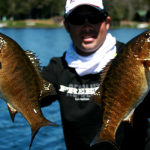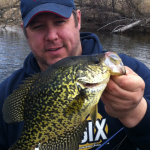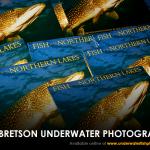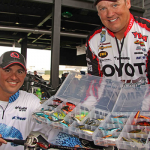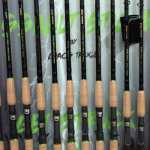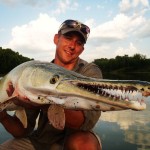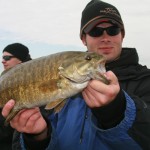By: Andrew Ragas – Date Posted: March 22, 2011
As winter draws to a conclusion, the days before us gradually turn warmer and longer. When air temperatures increase, creating snow-melt, large trickles of water meander into creeks, streams, and rivers.
When this process occurs, river shorelines and backwaters finally become accessible again to open water angling. In consequence, this changing of seasons enables us to pursue northern pike, the water wolf of all river systems.
The spawning behavior of pike is first observed as ice retreats from the banks of rivers and creek arms. During these days of early spring, sunlight penetration becomes critical in awakening fish, thus leading them into the fertile vegetated shallows of newly-filled river backwaters, side channels, and ditches to seek out ideal habitat for laying eggs.
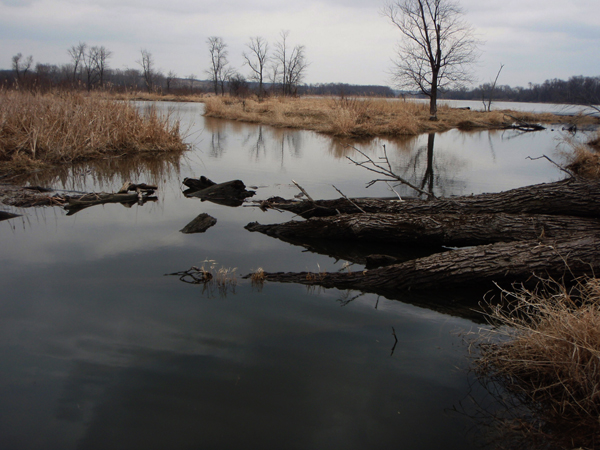
In comparison to other gamefish species, pike spawn in very cool water, immediately following ice-out. They are often the first species to spawn in most major river systems, preferring the temperature ranges of 35 to 45 degrees. During the spawning process, females will deposit as many as 100,000 eggs at random in shallow dense habitat they find to be most suitable for rearing their fry.
The scent of spring seeping into the river system appears to trigger the necessary response for anglers that the pike spawn is quickly approaching. At this time, the stage is now set for some of the biggest fish of the year to be highly concentrated and eager to feed.
For many anglers, the best locations to hunt down both numbers and sizes of northern pike are the shallow backwaters. If fishing large and deep river systems or flowages for example, boat access should be used. However, in my region where the river systems are shallow, small to mid-size, and require some stealth stalking, the only necessary means for travel are a set of comfortable waders.
In my mind, there is no better way of fishing for pike in rivers than to get down and dirty in the muddy backwaters with them.
Backwaters are ideal places to target pike during the spawn, and even for a period of several weeks after the spawn. These shallow secondary off-channel river habitats serve as overwintering areas, providing pike refuge from current as well as offering water temperatures that can be a few degrees warmer than the main river channel.
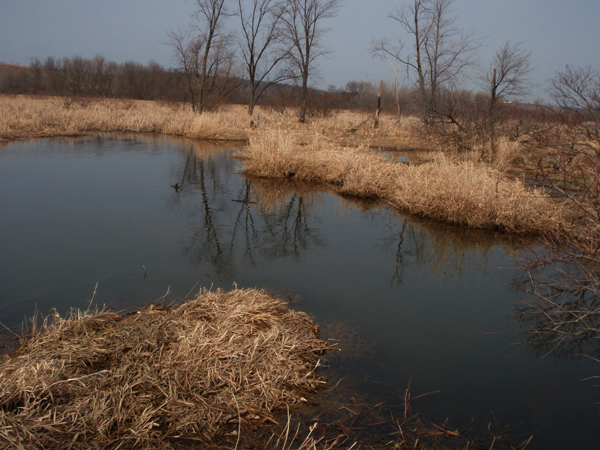
Shallow backwaters may not serve as year round wintering habitat, but pike seek them out most frequently for spawning purposes as they contain an abundance of ideal habitat. Prime habitat for successful pike spawning has proven to be newly flooded brush and vegetation. Cattail bays and marsh usually hold fish, but dense grass with nearby wood cover provides better spawning habitat and efficiently isolates eggs from predation.
Another important factor to keep in mind for backwaters is the amount of penetrating sunlight. Shallows that are baked by sunlight heat the fastest. If you can find a run of key shallow spots adjacent to deep water and the channel entrances, there is a good chance that you will find some of the biggest pike available in the river. When you locate potential key areas like this where pike are staging, there’s going to be different pike moving in and out of the area all day long.
For these same reasons, backwaters also attract other fish species pike feed on such as minnows, creek chubs, bluegills, suckers and large invertebrates including leeches. As water temperatures climb during the spawning period weeks, these forage species will also be active, attracted to the warmer water temperatures and habitat.

Based on most early season adventures, past experiences indicate that a mid to late afternoon outing is the standard procedure during these early season conditions. If locating productive water, scouting your locations during the early mornings and the hours leading up to your fishing pays huge dividends in angling productivity.
Before making your way over to the river, my suggestions are to first map out several good looking bays and creek arms through Google Earth, and BING satellite image software. These free programs are highly detailed in which you can sometimes notice depth changes, weed beds, laydowns, and shallow cover without even having to see the water for yourself.
Not only will you locate potential fishing spots by being a spy with satellite images, but you will also find your access areas to them.
In addition, information exchange via messaging and word of mouth is critical. Consulting and comparing notes with fellow river rats will oftentimes lead to gains in your own personal information such as possible spawning locations, fish movements, hot lures, and the moods of fish. Beforehand research like this will tremendously minimize your time in scouting and locating access areas, thus leaving you with more time to catch fish.
Once you have your backwaters located, and have confirmation that fish are present, it’s time to go to work.
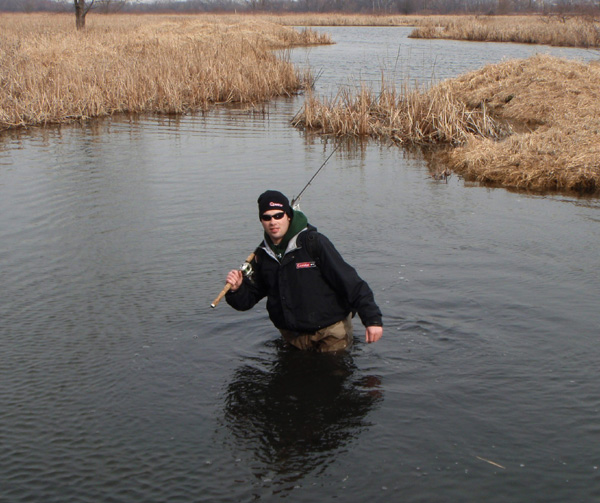
Compared to the main river channels, which will possess poor clarity at this time (especially in high water conditions), backwaters are often clearer, and excellent water filters due to being heavily vegetated. Since pike rely on their vision for feeding, presentations that add a visual attraction are top producers.
Many times, anglers often use big baits in order to catch the biggest fish available. In late summer into deep fall the big bait factor will hold true, but for early season not so much. Still, throwing large offerings does not always result in more strikes throughout the day. Using small to medium size lures will yield a lot of bigger fish by catching more fish overall. The big ones you end up catching will result as a function of percentages in the process
In early season fishing situations like this, pike are generally lethargic and finicky around the spawn period, and even during periods of heavy angling pressure. These variables affect your traditional lure selections for catching pike. Since the fish may be running hot (if unpressured and unmolested) or cold (if pressured or during post-frontal), it is important to bring a diverse selection of baits.
When wading, I often carry a backpack with a utility box with a variety of lures and mandatory leader material.
Spinnerbaits
Incorporating that bigger vs. smaller lure debate in catching more fish, traditional bass spinnerbaits between the sizes of 3/8 oz. to ¾ oz. excel for fishing along weed edges, and in extremely tight quarters to marshy shoreline cover where fish might be dropping eggs. In situations in which other lure options might get snagged in shallow cover, spinnerbaits avoid it.
One of my favorite spinnerbaits to use for pike is Northland’s Reed Runner in black with orange willow blade, and chartreuse/white with gold willow blade. In addition, Terminator’s T2 spinnerbaits work well, and hold up better because they are made from flexible titanium.
Trailer hooks aren’t required additions for your spinnerbaits unless experiencing a myriad of short strikes and missed fish. However, if used, your chances of having a tremendous weedless presentation diminish.
Lastly, it is mandatory for me to fish my spinnerbaits for pike with the addition of a plastic trailer. One of my absolute favorites is the 5 inch Stankx Thug Grub. Its extra-large profile tail adds to the effectiveness of the swimming spinnerbait presentation.
Bucktails and Inline Spinners
I seldom fish with anything larger than a size-5 blade during the early season – this even holds true for fishing muskies up north. The largest lures I will use in these situations are Mepps Musky Killers. However, pike that fall victims to angling pressure grow accustomed to seeing these all the time, plus the larger profiles and treble hooks have trouble staying weed-free. In high pressure angling situations, downsizing proves valuable.
Downsizing lures will make a big difference. #4 or #5 Mepps inline spinners are valuable when fish are running hot. In addition, the newcomers, Sims Spinners, have been exceptionally effective with their #5 single and double bladed models. With Colorado blades, these excel in running high through the water column, bulging beneath the surface. Sims specializes in creating custom tails and blades so that your lures can match all angling situations. Some of my favorite all-around pike combinations are single bladed such as black tail with orange blade, white tail with red blade, and chartreuse with black blade.
Rattlebaits
Rattlebaits tend to be overlooked by a vast majority of pike anglers. They are class of lures that you come across in most bass fishermen’s tackle boxes. However, in some situations, especially when fishing rivers with an abundant shad and shiner population, rattlebaits are dangerous.
With a cast and burn retrieve so that bottom contact is avoided, these noisy lures excel at tempting fish on pressured waters and during post-frontal conditions. In addition, they excel when fished in deeper pools within the backwater and around its outlets leading back out to the main river channel because the most active fish will be staging in this area, and infiltrating in and out.
When visual-related presentations fail, rattlebaits are a premium choice for when sound and vibration is needed. Some of my favorites are 5/8 oz. Rapala Clackin Raps, and 3/8 oz. Rattlin’ Rapala.
Jigs
Yep, you’ve got that right. When pike are so lethargic to the point that you cannot catch them on anything else, jigs with big plastic trailers swum past them will grab their attention.
Traditional ½ oz. to 3/8 oz. bass jigs work well under a wire leader. If weedless jigs aren’t in your bag of tricks, 3/8 oz. jig heads tipped with a 5 inch grub can catch several fish.
As far as models are concerned, Northland Jungle Jigs are my favorite due to their compact profile and thick brush guard. Nowadays, I fish all of my pike jigs with a Stankx 5 inch thug grub. I have found that black is by far, the best universal color because it works in any type of clarity, and makes your jig look like it is running with a giant juicy leech.
Jerkbaits
My favorites are slashbaits like the Rapala X-Rap 10. These lures give anglers the option to pause the bait at the right time, especially if fish might be lethargically trailing you. There is something to say about suspending baits that drive pike crazy, enough to make them strike with force.
Cast it out, crank some, add a few jerks, pause for 5 seconds. . . . . . Repeat process.
Chatterbaits
My favorite is the Strike King Poison. Fished in ½ oz., these skirted jigs with an independently moving metal lip attached to the jig head are quite possibly one of the most versatile shallow-water pike catching machines I have ever used. The key is how well they can deflect off of vegetation. It’s darn good if you asked me!
The blade does all the work for you by creating all the noise and vibration needed to get the attention of pike. Note – always tip with a trailer. Again, my favorite trailers are 5 inch Stankz Thug Grubz.
Weedless Spoons
Spoons are options that I seldom use because they have the perception of being so old-school, and oftentimes I forget that I even have them in my box. Based on popular pike culture, the ¾ oz. Johnson Silver Minnow tipped with a 3 inch plastic grub trailer is a longtime favorite that keeps on producing year after year.
If more flair is needed, and requested by fish, I also suggest giving Northland Jawbreaker Spoons a whirl. When all else fails, I should consider using these sometime soon.
Plastic Flukes
Sometimes, plastic tails aren’t meant to be served as trailers for jigs and spinnerbaits.
A new concept for me is catching pike on weightless jerkbaits. Twitch and glide plastics like the new Stankx 5 inch Flukez Minnow have a similar suspending characteristic to a naturally buoyant minnow as it can be cast, then jerked and paused several times until brought in.
Fished weedless with hook ‘texposed’ and weightless on a size 2/0 EWG hook (with leader mandatory), they can be worked anywhere in the water column, and easily outperform everything else on days when fish are lazy and lethargic.
Proper Gear
For shore stalking backwater pike, proper gear is a must-have, especially because you are dealing with a species of fish that requires being in good health following release. With egg-bearing females, this becomes critical.
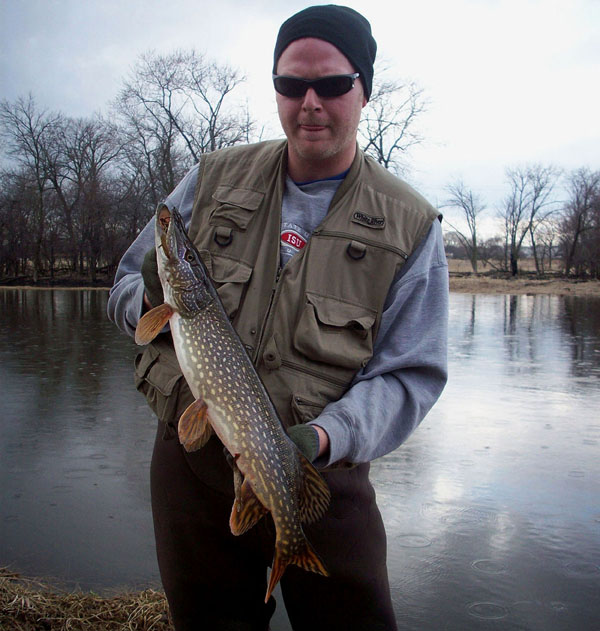
A good all-around multi-purpose outfit for me is a 6 and a half to 7 and a half foot medium heavy action casting rod with a reel spooled with 40lb braided superline. In particular, I enjoy fishing my 6 ft. 6 in. medium heavy Quantum Tour Edition PT with burner model Quantum Accurist PT. In addition, in situations when I know monster fish are likely to be caught, I beef my rig up to a 7 and a half foot medium heavy Quantum Blue Runner, a light saltwater rod. I pair it with a Quantum Cabo 30PT with 50lb braided superline.
I prefer using shorter rods in comparison to longer models because I often find myself in situations where I need to make awkward casts through flooded trees and brush. In addition, when pitching becomes necessary, I can maneuver through shallow water much easier when longer rods might prevent it from happening
Besides baitcasting options, heavier spinning tackle becomes an option, especially if you intend on fishing with finesse and utilizing live bait and dead-bait techniques beneath a float (forgive me for not expanding on this subject but it’s hard to when I have seldom tried it myself). Personally, I have yet to touch a spinning rod when in pursuit of backwater pike. However, I have friends who fish with 7 and 7 and a half foot, medium heavy action rods, and do very well with them.
When fishing for spawning pike this spring, angler ethics is a critical issue that will be encountered. Often, rapid decisions will be made for which fish to keep, whether or not you should trespass on someone’s land in order to reach the fish, or if a specific location is to be posted for others to know your whereabouts.
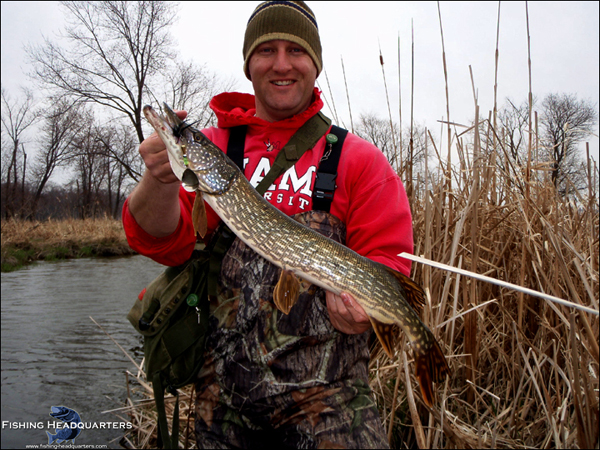
As conservative anglers, we must choose well for our own sake, as well as the vulnerable fish species that are being pursued for own recreational purposes.
Catching spawning pike is nothing different in comparison to catching other nesting species of fish. The only noticeable difference is in the way you are in pursuit of the quarry. With backwater pike from shallow mid-size rivers that are best fished while waded for example, this experience is one of the most unique ways I have successfully caught fish.
Like most other spawning grounds for pike, river backwaters are ecologically sensitive areas that have capabilities of rearing dozens of vulnerable fish at a time. Despite their large population densities in small isolated areas, they will not fare well when facing pressure, and even angler harvest.
On certain river systems where pike aren’t managed as thoroughly as they should be, with closed spring seasons to the north in Wisconsin and Minnesota for example, it is extremely important to fish with your head on straight. The most important aspect about this style of fishing is releasing pre-spawn fish so they fulfill their life cycle of producing the next generation of backwater inhabitants for eager and adventurous anglers to enjoy.
Locate your spots like I have described for you, and you will certainly get dirty in the backwaters at some point this spring.



